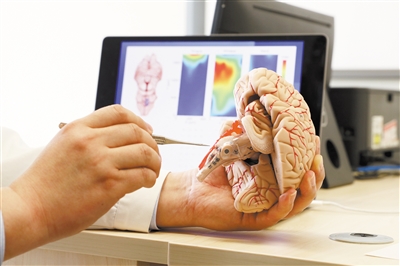
 |
| A researcher is demonstrating the use of the new flexible electrode on a brain model. (PHOTO: XINHUA) |
During a craniotomy, surgeons can precisely recognize the nerve nuclei and cortical functional areas in the brain by using a new flexible electrode. The new tool is composed of 2 μm size electrode points placed on the brain to maximize the protection of brain function and minimize the probability of disability and death from surgery. It can be applied to fields like brain-computer interface for rehabilitation of paralyzed patients.
A China-U.S. research team has recently proposed this new tool solution named "a flexible microarray electrode that fits tightly to irregular areas of the brain" and developed a novel conductive polymer material. As a major breakthrough in the field of stretchable organic electronic devices, the material remains conductive after being stretched several times, and stretchable and highly conductive even after being processed to 2 μm.
The flexible and stretchable electrode may be safely used in a variety of irregular or vulnerable areas of the brain, such as the brain stem and neurosurgical cavity. This means it will not be damaged by pulling or twisting of surgical instruments.
In addition, with high electrical conductivity and high density, the electrode can locate individual cells precisely, thus helping surgeons to "observe" the nerve nuclei in the brain directly in the form of a "heat map," which is conducive to the protection of brain function.
According to relevant reports, this is the most precise flexible stretchable microarray electrode in the world. Such flexible electrodes and electronic devices are expected to play an important role in brain science research and relevant clinical transformation, for they can not only promote the precision of neurosurgery, but also serve as a core technology for the brain-computer interface.


 Next
Next




